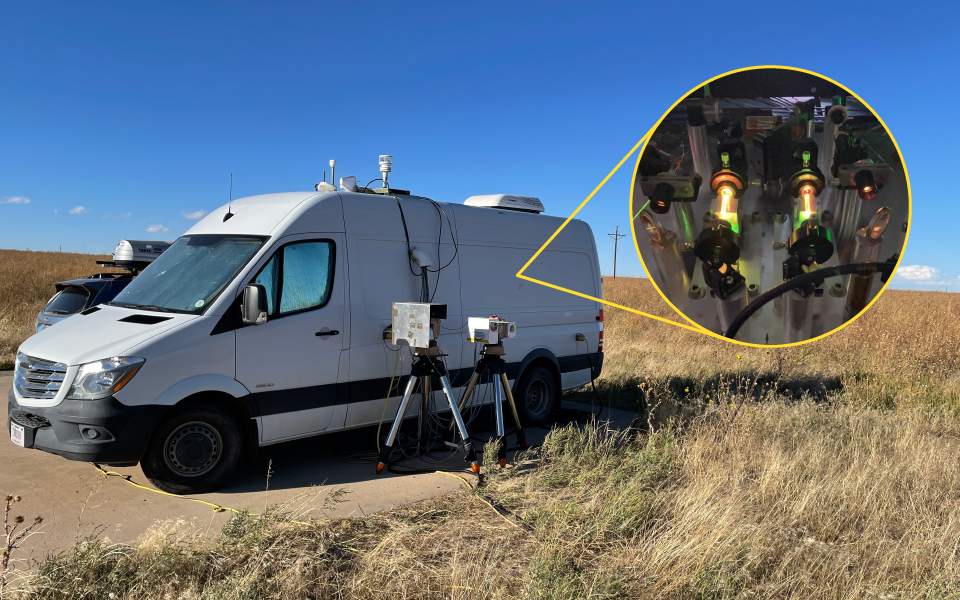- A more robust version of NIST’s frequency-comb technology can now measure methane and ethane emissions year-round, even in harsh climates.
- The NIST study found that methane emissions from agriculture, specifically concentrated animal feeding operations, were one and a half times higher than expected.
- Understanding and accurately measuring greenhouse gas emissions can help policymakers to craft better-informed policies to reduce emissions.

A research van housed a mid-infrared laser system (inset) and telescope, which directed light across the open air to a mirror several hundred meters away.
Researchers at the National Institute of Standards and Technology (NIST) have upgraded a highly precise technology designed to monitor emissions of methane, a critical greenhouse gas, and other trace gases, even in harsh field conditions. Measuring methane emissions and pinpointing their source is an important step toward reducing them — the goal of the Global Methane Pledge recently signed by more than 150 nations at the 2023 United Nations Climate Change Conference.
NIST’s upgraded emissions-monitoring technology allowed the research team to estimate methane emissions in a roughly 855 square kilometer (330 square mile) area of Northern Colorado for two months. The study, which examined emissions from two primary sources — agriculture, and oil and gas production — yielded two unexpected findings. First, methane emissions from concentrated animal feeding operations (CAFOs) were greater than predicted. Second, total emissions from oil and gas production in the study area appear to have plateaued over the last several years, despite rising production.
“Collecting this type of data is what’s useful for policymakers to see how emissions are changing over time so they can adjust regulations accordingly,” said Kevin Cossel, NIST researcher and co-author of the study.
Methane has approximately 30 times greater global warming potential than carbon dioxide over a 100-year period. Substantially reducing methane emissions can help reduce the risks of climate change. But to manage methane emissions, you need to measure them, which presents many technical challenges.
Traditional methods for tracking methane emissions are based on economic activity. For instance, one might calculate the emissions from a CAFO by multiplying the number of animals there by an estimate of how much methane each animal emits. The NIST method, on the other hand, estimates emissions by directly measuring the variation of methane and other gases in the atmosphere.
Precision Emission Measurement With Spectroscopy
The NIST setup uses frequency combs, a special type of laser with a broad spectrum of colors or wavelengths to measure gas concentrations along a path in the air. Methane and other gases will absorb specific wavelengths of that light, which then travels back to the setup after reflecting from a mirror deployed at a nearby location. A second frequency comb precisely measures how much light is absorbed at those wavelengths to determine the concentration of these gases and help pinpoint what type of source produced the emission.
Previous versions of this frequency comb spectrometer have been in use for several years, but the latest version boasts improved robustness, portability and adaptability to diverse climates.
“We had an early version of this system that we took out into the field, but if you look at the data, there’s lots of downtime when the system wasn’t functioning,” said Cossel. “We rebuilt the system to make it more temperature stable and improve the data collection process.”
Griffin Mead, NIST researcher and paper co-author, highlighted the system’s resilience in harsh conditions, compared to the previous version’s limitations. “We were not taking these measurements in the spring or fall when the weather is nice,” shared Mead. “This was in the winter in Colorado; it was snowing, sleeting, hailing, negative temperatures outside. But this new system operated beautifully in this type of extreme weather whereas the previous version would not have been capable of working in those conditions.”
The heart of this system, frequency combs built from fiber lasers used in the telecommunications industry, is already available commercially, opening the door for companies and labs to replicate this system nationwide.
Beyond Methane
The new system doesn’t just measure methane, but also other gases including ethane and ammonia. By simultaneously measuring and analyzing correlations between multiple gases, the study aimed to distinguish contributions from the oil and gas and agriculture sectors, which were then used to improve emissions estimates. This can provide a more comprehensive understanding of the sources and impacts of these pollutants.
The future of emissions monitoring is looking bright as Mead and Cossel plan to measure other gases, such as nitrous oxide emissions from wastewater treatment plants. “Our goal is to further refine the system’s sensitivity and precision and expand our research area. We’ll be doing studies near Salt Lake City within the next few years, which will provide some regional variations,” Cossel said.
As the global community intensifies its focus on reducing methane, this technology could play a crucial role in providing accurate and actionable information for scientists, industry leaders and policymakers.
Paper: Griffin J. Mead, Daniel I. Herman, Fabrizio R. Giorgetta, Nathan A. Malarich, Esther Baumann, Brian R. Washburn, Nathan R. Newbury, Ian Coddington and Kevin C. Cossel. Apportionment and Inventory Optimization of Agriculture and Energy Sector Methane Emissions using Multi-month Trace Gas Measurements in Northern Colorado. Geophysical Research Letters. Published online Jan. 9, 2024. DOI: 10.1029/2023GL105973

